Orion - the Hunter
We’re entering a more interesting astronomical calendar in 2018 than usual; and this has inspired me to start writing about the constellations and some of the astronomical events we’ll be seeing this year.
We have already witnessed a full moon on the night of 1 / 2 January 2018 - which some see as portentous - but the earliness of the event in the month, has signalled the fact that we're in for a blue moon 29,5 days later, on 31 January 2018. A blue moon (in one of its definitions) describes a month in which two full moons occur in the course of a single month.
But that is not all, this month’s blue moon (which we have seen has nothing to do with its colour, but rather its relative infrequency) is also going to be a blood moon - in which title we do find accurate reference to its colour - because, for a large part of the world, the moon will be in eclipse - turned red in the shadow of the earth.
It will also be a supermoon: a presentation of the moon within its annual calendar when it is visibly larger than normal. This occurs between 4 and 6 times a year when the moon comes closer to the earth than usual. This is the moons macro-phase, and is known as its perigee (as opposed to its apogee - when it is furthest from the earth), when it is approximately 14% larger and about 30% brighter than during its micro-phase. A supermoon looks bigger, not because of the optical illusion that makes the moon look bigger when near the horizon, but because the moon is in fact nearer to the earth than at other times.
So, we’re in for a blue bloody supermoon!
To read more about it, try this link: [source](http://www.independent.co.uk/news/science/super-blue-blood-moon-supermoon-next-lunar-eclipse-total-nasa-january-2018-a8142641.html#gallery).
But I digress: I thought to begin with description of the constellations - and to start with Orion - the Hunter.
Orion is a good place to start because at this time of the year it dominates our early night sky and is easily recognisable with its belt and sword sheath, and its bright stars, Betelgeuse and Rigel. Even if you live in a city, it can be seen through the light pollution that is the astronomer’s enemy. And for the Harry Potter fans: one of its prominent stars is known as Bellatrix (or Bellatrix was named after the star - as were several other Harry Potter characters, but more of that another time).
The constellation is bigger than your extended fist (which blocks out about 15 degrees of the sky) and is depicted in the following image:
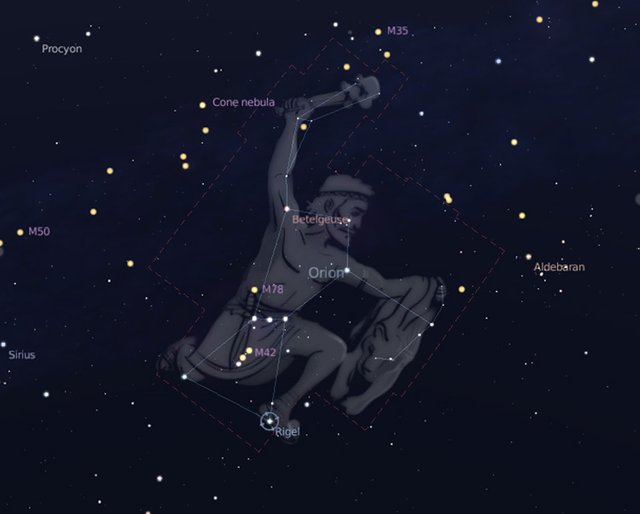
[image source](http://www.astronoo.com/en/winter-constellations.html)
If you looked at the sky with a shutter exposure, the stars would look like this image (this has been oriented for the photograph’s sake. Its visible orientation will differ from where you’re observing, and the time of the night).
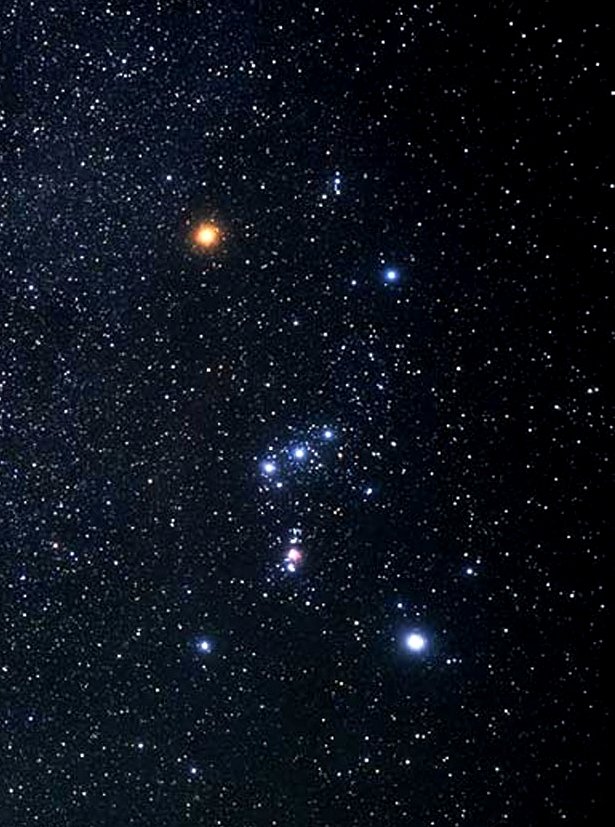
[image source](http://www.constellation-guide.com/constellation-list/orion-constellation/)
The stars are labelled in the following image:
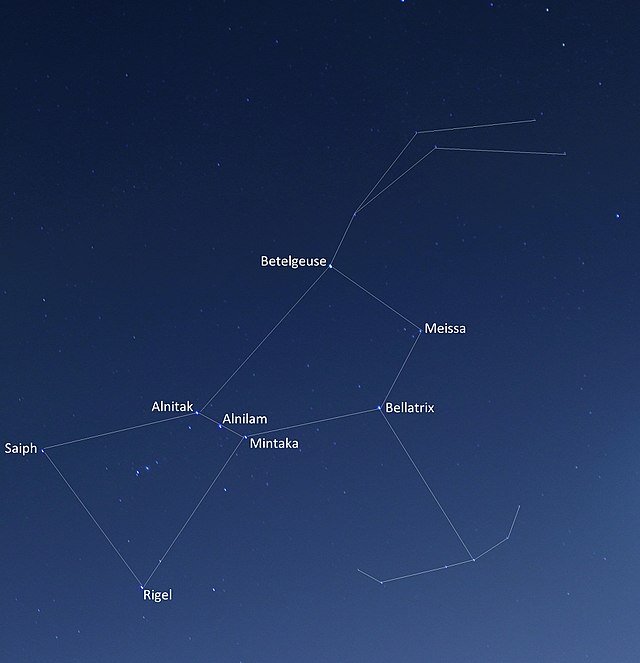
[image source](http://galinaokhotnik.ucoz.ru/index/orion_ori/0-106)
Betelgeuse (the reddish star at the Hunter’s head) is an old star - a red dwarf - that scientists expect to explode within the next million years. Well, it could be in our lifetimes ...
By contrast, Rigel, near the feet of the Hunter, is a blue-white star, signalling its relative infancy and energy.
And in the sword sheath, visible to the naked eye in a dark environment without light pollution, we can see the Orion Nebula, one of the most studied nebula in the sky. A nebula is a cloud of dust and gas. And in the case of the Orion Nebula, there are massive amounts of it - enough for it to be a wonderful birthing place of stars, igniting under their mass, and holding the promise of creating solar systems, and the possibility of life.
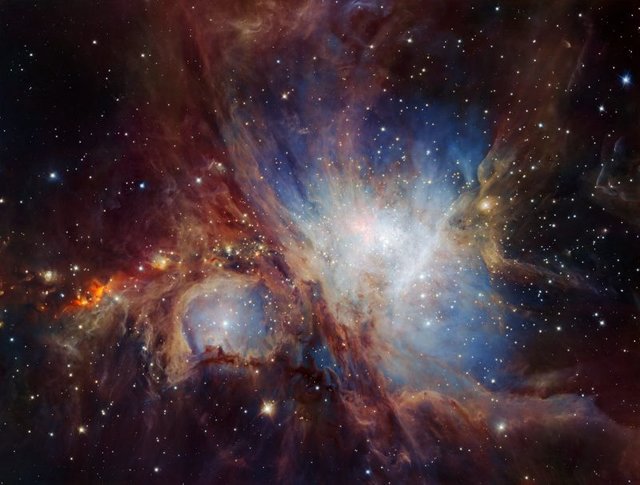
[image source](http://earthsky.org/clusters-nebulae-galaxies/orion-nebula-jewel-in-orions-sword)
National Geographic offer a 3D tour of this space cloud full of baby stars at this [link](https://news.nationalgeographic.com/2018/01/orion-nebula-3d-hubble-spitzer-brown-dwarfs-planets-space-science/)
Another famous nebula lying within the Orion Constellation is the Horse Head Nebula, viewed in this delicate infrared image from the Hubble Space Telescope.
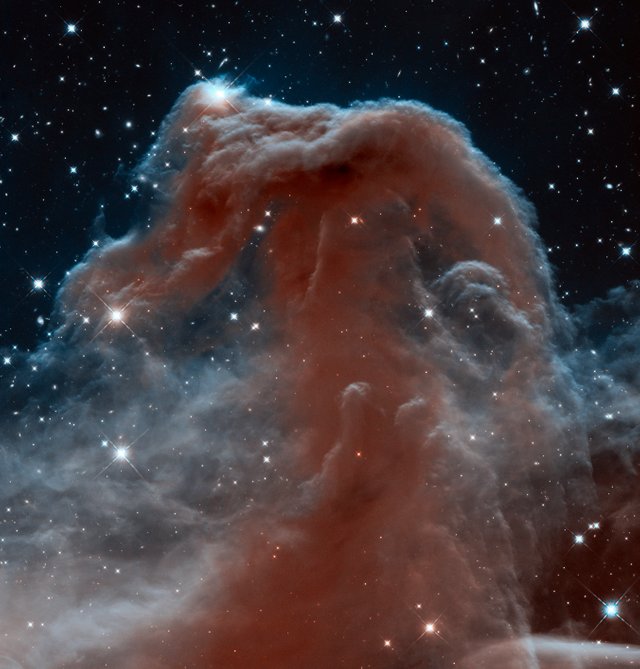
[image source]( )
)
Take a step outside at about 9 or 10pm and Orion should be right above you, on the celestial equator.
nice article, wonderful pics, thanks for sharing
it's really nice to see posts about astronomy here in steemit.
wonderful post .
Glad you liked it. Are you interested in astronomy too?
Good one
thanks!
Mr.@vuyusile
This is contrast, Rigel, near the feet of the Hunter, is a blue-white star, signalling its relative infancy and energy and is much feeling able . Thanks for sharing such a posts.
Yes Rigel is the seventh brightest star in the night sky. It is twice as hot and 40 000 times brighter than our sun.
really nice
Thanks for dropping a compliment ...
nice post, real content
in science thinking is main thing.
Agreed as long as hubris doesn’t take hold ....
Amazing for shearing news post
Very good
Thanks - hope you enjoy the series on constellations that will follow
its really good its like imagination ..
imagination fuels creation!
that true you can make anything from anything by just imagining
Nice write up !! Did look like a story
thanks!
IMPRESSIVE !
Generous praise!